This article is taken from the July 2024 issue of The Critic. To get the full magazine why not subscribe? Right now we’re offering five issues for just £10.
Walking south down Oxford’s Mansfield Road, it is hard not to be stopped in one’s tracks by the porter’s lodge of the Gradel Quadrangles, built for New College [2]. Opened only in April this year, and still awaiting their finishing touches, they are the newest addition to a city that contains arguably the country’s grandest suite of urban buildings but also its most curious.
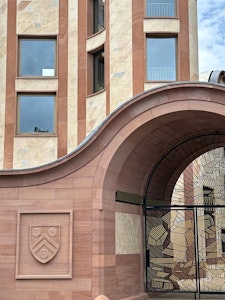
Seen as it is approached, obliquely, the bulging arch of the low-winged porters’ lodge contrasts vividly with the strict, Perpendicular lines of Thomas Worthington’s (rather uninspiring) chapel at Harris Manchester that stands behind it [3]. Looked at from the other side of the street, the lodge is dominated by a tower that looms ominously above it, bringing to mind Alfred Hitchcock’s Vertigo [1].
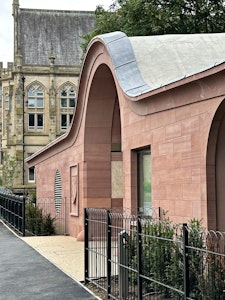
A walk around the perimeter does nothing to throw off the uncanny feeling. The building seems to slide inwards and outwards from older buildings facing the street like some kind of gigantic snake. The metal scales lining the roofs and staring ocular dormer windows do nothing to lessen the effect [4]. Taken together, the quadrangles feel like something out of a surrealist dreamscape. They are unsettling, strange and yet, it has to be said, at times beguiling
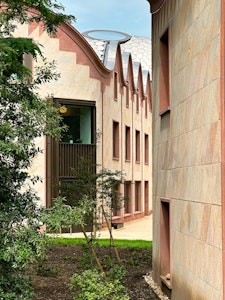
Designed by David Kohn architects — also notably responsible for “A Room for London”, the cabin that sat above London’s Hayward Gallery from 2012-16 — the Gradel Quadrangles are named after Chris Gradel, co-founder of the investment firm PAG.
They were built for a variety of purposes. One of the three quadrangles it comprises was built for New College School, the College’s adjacent school that still provides boy choristers for its celebrated choir,. The tower houses the newly-founded Gradel Institute of Charity, and there is also a concert hall.
But the primary motivation was to provide housing for undergraduates. With room enough for 200 students, the College can now offer accommodation on or near the College site to almost all its undergraduates for the whole period of their study.
This is the latest episode in an arms race between Oxbridge colleges in recent years. With students increasingly priced out of the conventional rental market, and conscious of getting value out of their fees, the often land-rich colleges have sought to provide greater access to student accommodation, more comfortable than what was on offer before.
All of the rooms come with en suites, a feature often absent from the more spartan college living quarters of yore (the days when communal baths, and not showers, were the only washing facilities on offer in these semi-monastic institutions are still in living memory). Of course, this comparative luxury is also aimed at a secondary market: namely, the conference guests who use these facilities when the undergraduates are away.
This new development therefore tells us much about the priorities of the collegiate university today. That is also true of the buildings’ design, which seeks to speak in an Oxford vernacular while deliberately standing apart from it.
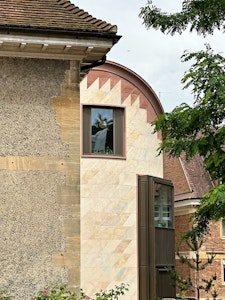
So much can be seen in the stone in which they are faced [5]. Oxford of course is a city of stone, but the stones used here set these buildings apart. The sandy-coloured Ancaster limestone of the quadrangles is lighter hued than the honeyed stone in which much of the city is built, and the Cumbria sandstone that accents parts of the buildings finds little match elsewhere in Oxford, save at William Butterfield’s chapel at Balliol College, controversial when first built and still so today.
For all their curves and bulges, engineered using the latest, most high-tech machinery — Zaha in stone, in other words — there are other ways in which the Gradel Quadrangles deliberately take their cues from the traditional architecture of the University. These largely residential buildings are, after all, not billed as halls of residence but quadrangles after the traditional Oxford fashion.
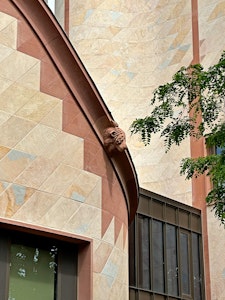
Other nods to Oxford traditions include a porters’ lodge, the internal division of the building into staircases and common rooms, and the addition of 25 animal grotesques [6] and gargoyles to the rooflines, each showing an endangered species. There is even a “dreaming spire” in the form of the tower, although the undulations of its plan make the dream in question seem a little Daliesque.
All of this signalling to Oxford’s past speaks of a commission that in architectural terms seeks to achieve the safety-first formula of “well-worn forms for new times”. As much appears to have been the aim of both the architects and the patron, the latter of whom made clear his desire that the buildings be built to stand for centuries. Of course, it would be nearly impossible to design for a university with an institutional memory as long as Oxford’s without some attempt to do this. But does it succeed?
There are times visiting the building when all of the gesturing feels just like that: gesturing. However they are billed, the quadrangles don’t feel like quadrangles, but rather strange, almost otherworldly dreamscapes. The references to older forms of collegiate building, moreover, do nothing to disguise the disruptive quality of the architecture. The curves and undulations deliberately break away from the centuries-old tradition that, albeit with notable exceptions, has seen Oxford University buildings conceived in primarily rectilinear terms.
Ultimately, it is hard to know what to make of the Gradel Quadrangles. Being generous, they could be described as bringing the spirit of the Art Nouveau to Oxford. Never quite achieving the Gaudi-esque however, they at times linger at the level of the Gaudi-ish. Some have likened them to the Hobbiton of Peter Jackson’s Lord of the Rings films.
Yet whether intentional or not, these evocations represent the belated arrival in Oxford of the spirited bricolage of the postmodernism, a moment of tangerine-coloured Californian sunshine that otherwise passed it by. They show us that even in the sincere, painfully self-conscious times in which we live it is still possible for dons to learn, as the great guru of Po-Mo Robert Venturi had it, from Las Vegas.
Enjoying The Critic online? It's even better in print
Try five issues of Britain’s most civilised magazine for £10
Subscribe



